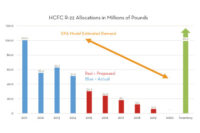In short order, the EPA published the proposed rules - “Ban on the Sale or Distribution of Pre-Charged Appliances” and “Adjustments to the Allowance System for Controlling HCFC Production, Import, and Export” - on Dec. 23, sat through a day-long hearing on Jan. 7 in which dozens of industry officials offered feedback, and then on Jan. 14 issued a Fact Sheet attempting to clarify some of the issues raised at the hearing.
As it is, the process is still not a done deal. Both proposed rules are currently in a period of public comment. The EPA said it would accept comments regarding its pre-charged equipment proposed rule until Feb. 6, and comments on HCFC production proposed rule until March 9.
According to Cindy Newberg, branch chief of the EPA’s Stratospheric Protection Division, “We are already considering issues raised at the public hearings and we will do as much as we can to facilitate the development of final rules. The general timeline for these types of rules is that once the comment period closes, EPA staff develops draft final rules. Those are reviewed within EPA first. Then they are submitted to the Office of Management and Budget that coordinates the interagency review. Afterwards the rules are sent back to EPA for signature.”
The best guess currently is that any signoffs on rulings would come this summer at the earliest.
WHAT'S WHAT
Based on readings of the proposed rules, and the subsequent fact sheet as well as industry comments, the EPA seems to be leaning toward allowing R-22 equipment manufactured before 2010 to be sold, installed, and serviced for the lifetime of such equipment. This runs counter to the initial perceptions of the industry that the proposed rules would have banned sales, installations, and possibly even servicing of such equipment. But now, according to the EPA fact sheet:• Sale and distribution would be allowed for self-contained, factory-charged appliances such as pre-charged window units, packaged terminal air conditioners (PATCs), and some commercial refrigeration units, if manufactured before Jan. 1, 2010.
• Sale and distribution would also be allowed for pre-charged appliance components that are manufactured before Jan. 1 and used for the purpose of servicing existing (pre-2010) appliances. This means, according to the EPA, that components such as condensing units, line sets, and expansion valves that are charged with refrigerant and completely manufactured before Jan. 1, but not yet installed in an appliance, could be sold and distributed for this purpose.
• Generally, sale and distribution would not be allowed for pre-charged appliances and pre-charged components charged with R-22, -142b, or a blend containing either and manufactured on or after Jan. 1.
• Split systems and other field-installed air-conditioning or refrigeration appliances could not be initially field-charged with virgin R-22, -142b or a blend containing either.
• Servicing of existing (pre-2010) appliances containing R-22 or R-142b would be allowed.
• A pre-charged component manufactured before Jan. 1 could be used to service an existing appliance. The EPA gave an example: “The regulatory text for the proposed pre-charged appliances rule lists condensing units as a type of component. Thus the proposed rules would not prohibit the sale or installation of stockpiled pre-charged condensing units that were manufactured before Jan. 1, and used to replace a condensing unit in an existing residential split system.”
• Components manufactured on or after Jan. 1, 2010, for the servicing of existing appliances could be sold and installed as long as they do not contain a charge of virgin R-22 or a blend with R-22 or –142b.
COMMENTS
The fact sheet helped dispel a number of concerns that arose at the hearing a week earlier. But many in the industry continue to shift through definitions and interpretations and also point out that the final ruling will probably not come until summer, pushing to within a few months of the rules taking effect.“While the EPA fact sheet clarifies some of the flaws with the rules as originally proposed, there are still outstanding issues to be resolved. For example, EPA did not conduct an economic impact analysis of the rules on small businesses, as required by the Regulatory Flexibility Act,” said Charlie McCrudden, director of government relations for the Air Conditioning Contractors of America (ACCA).
The issue that stirred most of the initial controversy concerned questions about being able to install R-22 equipment made before Jan. 1, 2010.
The proposed rule contained an “unconventional definition for the ‘date of manufacture’,” said Karim Amrane, vice president of regulatory policy and research for the Air-Conditioning, Heating, and Refrigeration Institute (AHRI). “It shifted the meaning from the date the equipment leaves the factory to the date it is installed.”
It was comments like that that touched off the initial furor, tempered somewhat by the fact sheet, but still sits on the minds of many in the industry until the proposed rules are revised and finalized later this year.
Publication Date:02/02/2009


